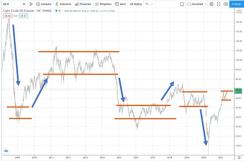By Bob Iaccino, for CME Group
AT A GLANCE
- More institutions and smaller, sophisticated traders will now be able to access WTI futures
- Pure supply and demand fundamentals are one reason for the popularity of traditional crude oil futures
With WTI, there are no exogenous fundamentals, meaning no CEO changes to worry about, no accounting scandals, no earnings reports. It’s just simple supply and demand. How much crude is out there and how much of it are consumers of crude currently consuming.
There are also plenty of interesting trends in oil markets. As mentioned above, crude oil is about supply and demand, which defines how it trades. Look at a long-term WTI chart and you will see sideways channels, followed by long trends, followed by sideways markets. Wash, rinse and repeat. If you catch a trend, you may be able to ride it for quite some time.

A long-term WTI crude oil chart shows sideways channels, followed by long trends, followed by sideways markets.
For a trader who knows how to manage risk, this is a compelling asset.
So, why isn’t everyone trading it? For many market participants, it may be related to the size of the benchmark contract. A standard WTI contract has a notional value of 1,000 barrels of oil times the agreed upon futures price and is also deliverable by physical oil upon expiration.
This has meant that WTI crude has often had too large of a margin requirement for many market participants and has been primarily used as an institutional hedging tool.
But as U.S. crude continues to gain significance in global oil markets, we have seen an increase in demand for additional tools to help a broader base of customers access the liquidity and transparency of the WTI contract, but with more flexibility and less margin upfront.
Here’s an example: Recently I was asked in a podcast to give my best trade setup for the day. It happened to be a long in WTI crude. The trade was buying CLN at $66.70, with a stop at $64.10 and a target of $70.10. This amounted to risking 260 ticks to make a possible 340 ticks, a solid 1.3/1 reward to risk ratio.
The dollar risk in the standard WTI contract would be $2,600 with a potential reward of $3,400. Someone with a $10,000 account, however, would be risking a whopping 26% of their total account value to place this trade. Even the E-Mini Crude contract, which would be half the risk in dollars and half the potential reward, would still reach 13% of the total account value. That is still too high a margin for some traders.
Enter CME Group’s new Micro WTI futures, which are scheduled to launch on July 12, 2021, pending regulatory review. Micro WTI will be one-tenth the size of the standard WTI contract and cash-settled, providing a new tool for traders to fine-tune their exposure to crude oil markets and enhance their trading strategies in a more precise way.
In the example above, a trader with a $10,000 account could take the same trade and only risk $260, (2.6% of total account value) to make a possible $340 per contract.
Instead of one standard WTI contract or two E-Mini WTI contracts, I can enter 10 Micro WTI contracts and portion out my exits, allowing me to capture more of the trend. Instead of cutting the entire trade at my target level of $70.10, I can sell two there and then two more at $72.10 and two more at $74.10, $76.10, and $78.10 for a blended average exit price of $74.10. That would bring the profit from $3,400 to $7,400. One could also scale into a larger position in the same fashion.
With Micro WTI futures, a wide array of market participants – from institutions to smaller, sophisticated active traders – will now be able to access the benefits of the global benchmark WTI futures. Risk-control will now be more efficient, and the market on a fascinating commodity functioning on supply and demand will be more accessible.
Read more articles like this at OpenMarkets






